Sony Alpha DSLR-A550
-
-
Written by Gordon Laing
Sony Alpha DSLR-A550 verdict
Sony’s latest mid-range DSLR, the A550, is an important addition to the Alpha range. After the modest refresh of its entry-level threesome, Sony needed a decent brand new model to impress in the tough mid-range DSLR market – after all, any player here is up against big-hitters like Canon’s EOS 500D / T1i and Nikon’s D5000 and D90.
Thankfully for anyone doubting the Alpha range, Sony has delivered not one, but two highly compelling mid-range DSLRs which not only keep-up with the competition, but surpass them in a number of key regards. Sony’s also done its homework and unlike some cameras which simply jump on the bandwagon of fashionable features, the Alpha A550 and its more affordable sibling, the A500, actually target a genuine desire of many photographers. In a word: speed.
When many people trade-up from a point-and-shoot camera or an entry-level DSLR, they want something which is faster. They want to capture bursts of action which have eluded them at the typical 2-3fps of cheaper cameras. They want 5fps or quicker still, but can’t stretch to a semi-pro model. And if they’re upgrading from a compact, they also still want to frame with the screen and not worry about compromised operation.
It sounds like a simple enough request, but one which virtually all mid-range DSLRs fail to address. Sure continuous shooting speeds are gradually accelerating and Live View modes becoming less fussy, but if you want 5fps or faster from a DSLR, you’ll normally have to spend big bucks, and even then, you’ll only enjoy the full speed and continuous autofocus when composing through the viewfinder.
Enter the Alphas A500 and A550, which boast 5fps at a lower price than you’d normally have to pay, along with a fuss-free Live View system which uniquely supports continuous autofocus. In short, if you want to shoot fast action on a lower budget, and ideally frame it with the screen, then these are the DSLRs for you.
The A500 and A550 really do offer comfortably quicker continuous shooting than similarly-priced DSLRs, and if you’re happy for the focus and exposure to be locked on the first frame, the A550 approaches semi-pro speeds with its optional 7fps Speed Priority mode. This mode may be unsuitable for capturing action which is moving towards or away from you or across different lighting conditions, but can still be useful for grabbing, say, the stunts of a skateboard, skier or mountain bike. And if you do need autofocus and exposure, then the normal 5fps mode is still faster than anything else at this price.
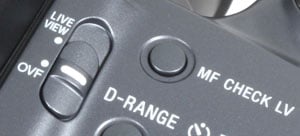 |
Compared to other DSLRs, Sony’s quick and fuss-free Live View system continues to be a revelation in use. Just flick the switch and you’re instantly ready-to-go without any noise, interruption to the image or compromise to the autofocus. Since the A500 and A550’s main Live View system uses a secondary sensor in the viewfinder head to effectively film the focusing screen, it can also use the main phase-change AF system – so the AF in Live View is exactly the same speed as when shooting with the viewfinder, and unlike any other DSLR, you can also use continuous AF while framing with the screen. DSLR traditionalists may scoff, but we’ve seen enough people framing almost exclusively in Live View on a DSLR to know a camera which does it quickly and smoothly will be very appealing to a certain market.
Sony’s also cleverly integrated face detection into Live View, which thanks to the speed of the phase-change AF system, is much faster and more usable than other DSLRs. The only caveat is ensuring enough of the subject’s face falls over one of the nine AF points, but this actually covers most compositions.
Filming the focusing screen does have its downsides though, such as reduced coverage and lack of magnified focusing assistance, not to mention seeing any etched AF markings relayed on the screen. But Sony’s addressed all of these here, with a new alternative Live View mode which uses the main sensor to deliver 100% coverage and magnified assistance; this may not be as quick as the main Live View system, but will satisfy those with critical requirements. The focusing screen also now employs transmissive LCD AF markings which can be simply switched-off to allow an uncluttered view.
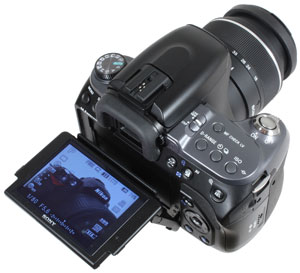 |
Rounding-off Live View, the vertically tilting screens allow you to easily compose at high or low angles, and if you go for the A550, you’ll also enjoy a lovely, detailed VGA panel – indeed it’s the first 3in VGA screen to be articulated.
On top of this, like all Alphas you get built-in stabilisation which works with any lens you attach – you may not see its reassuring effect through the viewfinder or on-screen during composition, but for many people this will be outweighed by enjoying stabilisation on any lens including shorter primes. Both new Alphas also offer in-camera HDR capture, an easy user interface designed with beginners in-mind, Sony’s Smile Shutter mode which can wait until your subject looks sufficiently happy before automatically taking the shot, and HDMI ports for connection to HDTVs.
As for image quality, the A550 delivers clean and detailed photos albeit lacking the vibrancy of cameras aimed at beginners. If you’re coming from a point-and-shoot, especially a Sony model, you’ll find the default processing a little drab, but it’s easily boosted if that’s what you prefer.
Noise levels were kept under control with the A550 only really beginning to struggle at its highest sensitivities. Unfortunately rather than let the grain become too visible, Sony employs its usual smearing at the higher ISOs with only Normal or High noise reduction to choose from for JPEGs. But as you can see in our results and gallery pages, it still performed respectably – indeed it’s the best performance we’ve seen from a cropped-frame Sony body to date. Don’t expect any more detail than leading 12 Megapixel models like Nikon’s D5000 and D90 though. As for the A500, we hope to compare its image quality against the A550 in the future.
So far it’s looking very positive for the new Alphas, but they’re not without their faults. Most obviously for a company which embraces gadgetry, neither the A500 nor A550 offer video recording facilities. This may not bother you personally, but it’s important to note all rival mid-range DSLRs, including some cheaper models, offer a movie mode.
Digging deeper, the flipside to such a successful Live View system is inevitable compromise in other areas of operation. Sony may have improved the size of the viewfinder on the A500 and A550, but it’s still quite small, and annoyingly the LCD AF points which so neatly disappear in Live View, each employ a fine but visible horizontal line connecting them to the sides of the frame. These lines may disappear when an AF point isn’t active, but with all nine displayed when your finger’s off the shutter release, composition with the optical viewfinder can become a little distracting with certain subjects.
At this price-point, the A500 and A550 are also lacking a number of features enthusiasts generally take for granted. There’s minimal customisation, no depth-of-field preview and strangely no Program shift either.
Then there’s the HDMI port which may be a plus-point, but less of one when it comes at the cost of a standard TV output. Like the entry-level Alphas, the A500 and A550 only offer an HDMI connection for TVs, so if you own an older or cheaper set without HDMI, you won’t be enjoying any slideshows on it. And while we love the idea of in-camera HDR, none of the example images we shot with it were preferable to standard single-frame JPEGs.
Which now brings us to our comparisons with key rivals before wrapping-up the verdict.
Compared to Canon EOS 500D / Rebel T1i
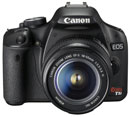 |
Canon’s EOS 500D / Rebel T1i is one of the best-selling mid-range DSLRs around right now, so represents a major rival for the Alpha A550. Both cameras feature 3in VGA screens with Live View, maximum sensitivities of 12,800 ISO, 18-55mm kit lenses and HDMI outputs, but there are considerable differences to weigh-up.
Arguably the biggest feature in the EOS 500D / T1i’s favour is a movie mode, which on the Canon can shoot at either 720p in a smooth 30fps or 1080p at a less fluid 20fps. It also has a depth-of-field preview, comes with free software to remote control the camera from a PC or Mac, is almost 150g lighter for the body and battery alone, and boasts an extra Megapixel of resolution, although the difference is barely noticeable. If we’re being picky, the Canon also displays the ISO value at all times in the viewfinder, whereas the Sony does not, and it additionally features more consistent on-screen adjustment of settings.
In its favour, the Alpha A550 features built-in stabilisation which works with any lens you attach, an articulated screen which vertically tilts to face directly up or down, much faster continuous shooting at 5fps with AF or 7fps without, a choice of two Live View modes, one of which is much faster than the Canon while additionally supporting continuous AF, and a face detection system which is actually usable thanks to the phase-change AF behind it. The battery also delivers an accurate percentage of charge remaining, there’s in-camera HDR capture, and first-time DSLR owners may find the user interface more approachable.
The only aspect where the Sony really falls down in the comparison is the lack of video recording, and of course this may not bother you at all. But for all its benefits, the A550 is a comfortably more expensive camera than the EOS 500D / T1i, so if the Canon better matches your budget and you’re after video recording, it remains a tough camera to beat. See our Canon EOS 500D / Rebel T1i review for more details.
Compared to Nikon D5000
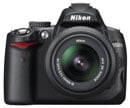 |
Nikon’s D5000 is another best-selling mid-range DSLR, so represents another key rival for the A550. Both cameras feature articulated screens with Live View, 18-55mm kit lenses and HDMI ports, but like the Canon above, there are many differences to weigh-up.
Once again, the biggest feature in the D5000’s favour is a movie mode, which shoots at 720p in 24fps. In addition, its screen may be smaller and less detailed, but enjoys greater articulation, turning to the side or front for crafty self-portraits, not to mention back on itself for protection. The D5000’s viewfinder features on-demand grid lines, there’s a more sophisticated 11-point AF system, superior metering, interval-shooting, a time-lapse movie mode, and while it’s a personal thing, we also preferred its ergonomics.
In its favour, the Alpha A550 features built-in stabilisation which works with any lens you attach, faster continuous shooting at 5fps with AF or 7fps without, a choice of two Live View modes, one of which is much faster than the Nikon while additionally supporting continuous AF, double the maximum sensitivity, and a face detection system which is actually usable thanks to the phase-change AF behind it. The battery also delivers an accurate percentage of charge remaining, there’s an optional battery grip and also in-camera HDR capture. The A550 also features two extra Megapixels, although this didn’t make a great deal of difference in our real-life tests.
So once again the Sony stacks-up well, with video recording being the only really major feature lacking in comparison to the D5000. But again there’s a number of small but valuable benefits to the D5000 which may make it preferable overall, especially at the lower kit price. See our Nikon D5000 review for more details.
Compared to Nikon D90
 |
Everyone’s comparing the A550 against the Canon 500D / T1i and Nikon D5000, but in terms of price, it’s actually a lot closer to Nikon’s higher-end D90. The D90’s kit price may be higher thanks to a longer and classier lens, but checking their body-only prices reveals them to be almost the same at the time of writing. So what are the differences?
In its favour, the D90 features a movie mode which shoots at 720p in 24fps, a larger and brighter pentaprism viewfinder with on-demand grid lines, a more sophisticated 11-point AF system, more reliable metering, a depth-of-field preview, an upper LCD information screen and considerably greater customization, along with superior build and ergonomics while only weighing a few grams more. And while the kit price is higher than the A550, you are getting a classier lens with internal focusing and almost double the maximum focal length.
In its favour, the Alpha A550 features built-in stabilisation which works with any lens you attach, an articulated screen which vertically tilts to face directly up or down, faster continuous shooting at 5fps with AF or 7fps without, a choice of two Live View modes, one of which is much faster than the Nikon while additionally supporting continuous AF, double the maximum sensitivity, and a face detection system which is actually usable thanks to the phase-change AF behind it. The battery also delivers an accurate percentage of charge remaining without delving into menus and there’s also in-camera HDR capture. The A550 additionally features two extra Megapixels, although this didn’t make a great deal of difference in our real-life tests.
As with our earlier comparisons, the Sony A550 stacks-up well in terms of features, with video recording being the only major one missing. But while it’s quicker than the D90, many enthusiasts will prefer the D90 for its bigger viewfinder, superior ergonomics and greater degree of customisation, not to mention a kit lens which zooms almost twice as long. Forgetting about movies, it’s a classier camera and still has a great deal of appeal for both traditionalists along with those who fancy trying their hand at DSLR-video. Overall the A550 may out-feature the D90 on paper, but pick up both models in person and you may prefer the Nikon. See our Nikon D90 review for more details.
Compared to Sony Alpha DSLR-A500
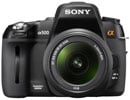 |
And finally, the closest rival to the A550 is of course its more affordable sibling, the A500. The Alpha A500 shares the same body, built-in stabilisation and tilting monitor mount as the A550, but hits a lower price-point thanks to three main lower specifications.
The A500’s resolution falls from 14.2 to 12.3 Megapixels, the screen size remains 3in, but its resolution drops from VGA (920k) to QVGA (230k), and finally, the A500 is lacking the A550’s 7fps shooting in AF-locked ‘Speed Priority’ mode, although both cameras shoot at the same respectable 5fps with AF.
So like the entry-level range, Sony allows you to choose the model with the features to match your requirements, while maximising its presence on retail shelves. It’s certainly impressive to find Sony now offering no fewer than five affordable DSLRs to consumers, when rival manufacturers generally have just one or two to choose from – indeed it ensures any potential Sony customers stick with the brand rather than considering a rival because it’s a little cheaper or better-featured.
As for comparing the A500 against the A550, the VGA screen is nice but won’t affect image quality, the Speed Priority shooting is quick, but limited with fixed focus and exposure, while the extra two Megapixels won’t make a significant difference in real-life detail – indeed the lower resolution may even allow the A500 to enjoy better noise levels and we look forward to putting this to the test in the future.
So if you can live without the A550’s frills, the A500 represents a great buy, and you could put the money saved towards a better lens. Indeed it’s the cheapest DSLR with 5fps continuous shooting, so if you’re into action photography on a budget, it should be high on your list. Once again we hope to review it in the future.
Sony Alpha DSLR-A550 final verdict
Sony’s Alpha DSLR-A550 may not have video recording, but becomes one of the fastest DSLRs in its class, not to mention one which delivers the most-rounded and usable Live View experience to date. The ability to capture fast action while framing with the screen sounds like a simple request, but it’s one which eludes the majority of DSLRs. Not so with the A550, and its cheaper sibling the A500, which manage it with ease.
Depending on your requirements, this may be all you need to know. DSLRs which shoot at 5fps or quicker are necessary for serious action photography, but normally carry semi-pro price tags. The A550 and especially the A500 bring this capability to a more affordable price-point, making them a top choice for anyone who wants to shoot action on a tighter budget. The ability to switch into Live View in an instant and still enjoy fast continuous shooting, along with continuous autofocus too, is the icing on the cake.
Factor-in built-in stabilisation which works with any lens you attach and a large detailed screen which tilts to face up or down, along with a beginner-friendly user interface, in-camera HDR and an HDMI port, and you’ve got a highly compelling, not to mention fairly unique mid-range DSLR.
As described above, the downsides are a lack of features which enthusiasts take for granted (such as a depth-of-field preview, broad customisation and Program Shift), along with the absence of a movie mode. As such, the A550 misses out on our top award, as many enthusiasts or those who simply want video recording will be more comfortable with a different camera, such as one of those listed above. No doubt Sony will also address these requirements with a revitalised A700 series in the near future.
But once again if you want fast continuous shooting at a reasonable price, or a fuss-free Live View experience, the Alpha A550 is one of the most compelling options around right now. Indeed there’s only one other model we can name which comes close in these respects – and that’s the Alpha A500. With these two models, Sony’s significantly enhanced its DSLR range and thrown down the gauntlet for handling in the mid-range category. So long as you’re happy to trade video and the features mentioned above for speed and fuss-free operation, the A550 easily comes Recommended. But like the A380 before it, the cheaper sibling – in this case the A500 – could end up being the preferred choice.
Bad points | Scores (compared to 2009 mid-range DSLRs) |
 | ||
Build quality: Image quality: Handling: Specification: Value:
Overall: |
14 / 20 17 / 20 18 / 20 18 / 20 17 / 20
84% | |||




